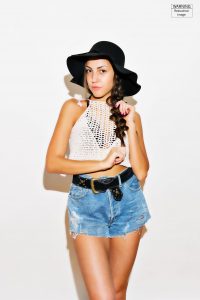Our project initially stemmed from our mutual observations about beauty standards and media influences on appearance ideals. We had both discussed the pervasiveness of thin-ideal imagery juxtaposed with the growing movement of body positivity and natural beauty, and we were curious to investigate measures that could counteract the body dissatisfaction that arises from viewing thin-ideal media.
 Crafting our survey was especially enlightening to see how entrenched conventional, thin-ideal beauty standards were, even in our own minds. To create our experimental conditions, we had to take our unedited images and critique the models’ weight, body shape, complexion, and other physical features to make them more like “main-stream” advertisement figures. Two of our conditions involved having the figures in our images resemble the Photoshopped models found in real-world advertisements, and this translated to us looking at the unedited models and saying things like, “her waist could be smaller,” or “her skin could be smoother.” It was frighteningly easy to look at the models in the images and pinpoint exactly how they could be “improved” (read: airbrushed and slimmed) to look more like advertisement models. I tried to trace the origins of my own perceptions about Western beauty and found that I couldn’t: those tall, slender, clear-skinned ideals had been there for as long as I could remember.
Crafting our survey was especially enlightening to see how entrenched conventional, thin-ideal beauty standards were, even in our own minds. To create our experimental conditions, we had to take our unedited images and critique the models’ weight, body shape, complexion, and other physical features to make them more like “main-stream” advertisement figures. Two of our conditions involved having the figures in our images resemble the Photoshopped models found in real-world advertisements, and this translated to us looking at the unedited models and saying things like, “her waist could be smaller,” or “her skin could be smoother.” It was frighteningly easy to look at the models in the images and pinpoint exactly how they could be “improved” (read: airbrushed and slimmed) to look more like advertisement models. I tried to trace the origins of my own perceptions about Western beauty and found that I couldn’t: those tall, slender, clear-skinned ideals had been there for as long as I could remember.
Spending the nine weeks working on our project allowed me to turn over and examine every opinion that I held on beauty and health slowly, and through multiple lenses. In a subjective concept like beauty, we were struck by how narrow the standards seemed to be. Yet we did find some hope for more open and diverse beauty standards in the future: as we critiqued the models in our images, we also explored different body positive movements that have gained steam in recent years. Major retail brands like American Eagle and beauty companies like Dove are embracing a broader interpretation of beauty, while grassroots social media campaigns and popular culture are also breaking from antiquated, rigid ideals.
